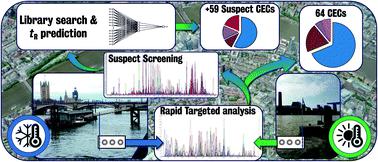当前位置:
X-MOL 学术
›
Anal. Methods
›
论文详情
Our official English website, www.x-mol.net, welcomes your feedback! (Note: you will need to create a separate account there.)
Rapid direct analysis of river water and machine learning assisted suspect screening of emerging contaminants in passive sampler extracts
Analytical Methods ( IF 3.1 ) Pub Date : 2020-12-30 , DOI: 10.1039/d0ay02013c Alexandra K Richardson 1 , Marcus Chadha , Helena Rapp-Wright , Graham A Mills , Gary R Fones , Anthony Gravell , Stephen Stürzenbaum , David A Cowan , David J Neep , Leon P Barron
Analytical Methods ( IF 3.1 ) Pub Date : 2020-12-30 , DOI: 10.1039/d0ay02013c Alexandra K Richardson 1 , Marcus Chadha , Helena Rapp-Wright , Graham A Mills , Gary R Fones , Anthony Gravell , Stephen Stürzenbaum , David A Cowan , David J Neep , Leon P Barron
Affiliation

|
A novel and rapid approach to characterise the occurrence of contaminants of emerging concern (CECs) in river water is presented using multi-residue targeted analysis and machine learning-assisted in silico suspect screening of passive sampler extracts. Passive samplers (Chemcatcher®) configured with hydrophilic–lipophilic balanced (HLB) sorbents were deployed in the Central London region of the tidal River Thames (UK) catchment in winter and summer campaigns in 2018 and 2019. Extracts were analysed by; (a) a rapid 5.5 min direct injection targeted liquid chromatography-tandem mass spectrometry (LC-MS/MS) method for 164 CECs and (b) a full-scan LC coupled to quadrupole time of flight mass spectrometry (QTOF-MS) method using data-independent acquisition over 15 min. From targeted analysis of grab water samples, a total of 33 pharmaceuticals, illicit drugs, drug metabolites, personal care products and pesticides (including several EU Watch-List chemicals) were identified, and mean concentrations determined at 40 ± 37 ng L−1. For targeted analysis of passive sampler extracts, 65 unique compounds were detected with differences observed between summer and winter campaigns. For suspect screening, 59 additional compounds were shortlisted based on mass spectral database matching, followed by machine learning-assisted retention time prediction. Many of these included additional pharmaceuticals and pesticides, but also new metabolites and industrial chemicals. The novelty in this approach lies in the convenience of using passive samplers together with machine learning-assisted chemical analysis methods for rapid, time-integrated catchment monitoring of CECs.
中文翻译:

河水的快速直接分析和机器学习辅助对被动采样器提取物中新兴污染物的可疑筛选
使用多残留靶向分析和计算机辅助机器学习,提出了一种新的快速方法来表征河水中新兴关注的污染物 (CEC) 的发生情况被动采样器提取物的可疑筛选。在 2018 年和 2019 年的冬季和夏季活动中,配置有亲水-亲油平衡 (HLB) 吸附剂的被动采样器 (Chemcatcher®) 部署在伦敦中部泰晤士河(英国)集水区。(a) 用于 164 个 CEC 的快速 5.5 分钟直接注射靶向液相色谱-串联质谱 (LC-MS/MS) 方法和 (b) 与四极杆飞行时间质谱 (QTOF-MS) 方法耦合的全扫描 LC使用超过 15 分钟的数据独立采集。通过对抓取水样的针对性分析,共鉴定出 33 种药物、非法药物、药物代谢物、个人护理产品和杀虫剂(包括几种欧盟观察名单化学品),平均浓度为 40 ± 37 ng L -1. 对于被动采样器提取物的针对性分析,检测到 65 种独特的化合物,并在夏季和冬季活动之间观察到差异。对于嫌疑人筛查,基于质谱数据库匹配,另外 59 种化合物入围,然后是机器学习辅助的保留时间预测。其中许多包括额外的药物和杀虫剂,但也包括新的代谢物和工业化学品。这种方法的新颖之处在于使用被动采样器和机器学习辅助化学分析方法对 CEC 进行快速、时间集成的集水区监测的便利性。
更新日期:2021-01-12
中文翻译:

河水的快速直接分析和机器学习辅助对被动采样器提取物中新兴污染物的可疑筛选
使用多残留靶向分析和计算机辅助机器学习,提出了一种新的快速方法来表征河水中新兴关注的污染物 (CEC) 的发生情况被动采样器提取物的可疑筛选。在 2018 年和 2019 年的冬季和夏季活动中,配置有亲水-亲油平衡 (HLB) 吸附剂的被动采样器 (Chemcatcher®) 部署在伦敦中部泰晤士河(英国)集水区。(a) 用于 164 个 CEC 的快速 5.5 分钟直接注射靶向液相色谱-串联质谱 (LC-MS/MS) 方法和 (b) 与四极杆飞行时间质谱 (QTOF-MS) 方法耦合的全扫描 LC使用超过 15 分钟的数据独立采集。通过对抓取水样的针对性分析,共鉴定出 33 种药物、非法药物、药物代谢物、个人护理产品和杀虫剂(包括几种欧盟观察名单化学品),平均浓度为 40 ± 37 ng L -1. 对于被动采样器提取物的针对性分析,检测到 65 种独特的化合物,并在夏季和冬季活动之间观察到差异。对于嫌疑人筛查,基于质谱数据库匹配,另外 59 种化合物入围,然后是机器学习辅助的保留时间预测。其中许多包括额外的药物和杀虫剂,但也包括新的代谢物和工业化学品。这种方法的新颖之处在于使用被动采样器和机器学习辅助化学分析方法对 CEC 进行快速、时间集成的集水区监测的便利性。


























 京公网安备 11010802027423号
京公网安备 11010802027423号